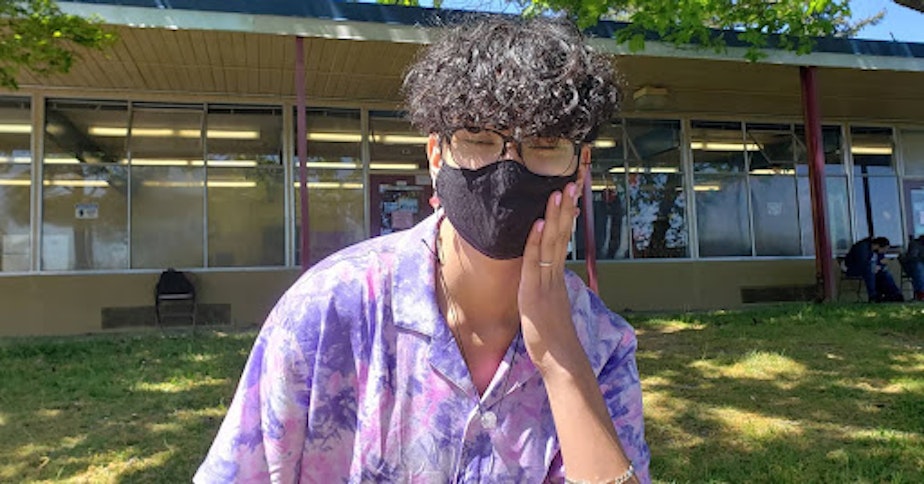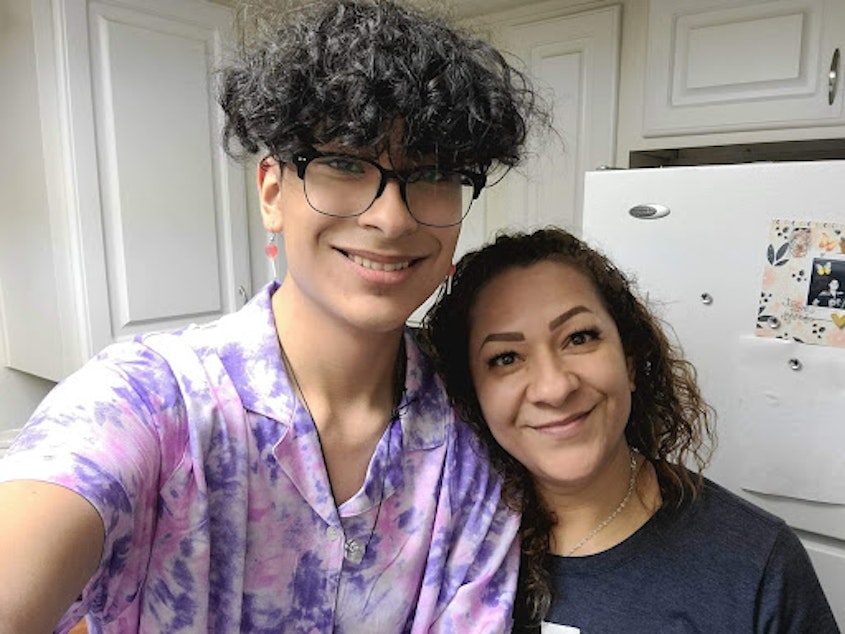How the pandemic gave me courage to explore my feminine side

Away from school hallways and cafeterias, some young people took time during quarantine to explore their identities.
That was the case for RadioActive youth producer Antonio Nevarez, who wanted to know why understandings of masculinity seem so limiting.
[RadioActive Youth Media is KUOW's radio journalism and audio storytelling program for young people. This episode was entirely youth-produced, from the interviewing and writing to the audio editing.]
G
rowing up, I was always told to act like a man, and that I had to look manly. I was taught that only girls could wear skirts and dresses, and that I couldn’t have anything that was pink.
Sponsored
Except, I actually love how dresses and skirts look, and pink is my favorite color. So why can’t I enjoy these things without being judged if it’s simply what I like? I thought of this question for a while and finally answered it myself: I get to decide what I wear.
But my parents always expected me to be a manly man — and nothing else. I asked my mom, Cecilia Nevarez, where these ideas came from.
"Pues, en mi familiar, siempre mucho machismo, y por eso me parece un poquito extraño todo esto," my mom says in Spanish. "Well, in my family, everyone was very machismo, and that's why all of this is a little strange to me now."
T
Sponsored
o see the difference between men's and women's clothing in an actual store, I decided to go to the Southcenter Mall where I wandered around JCPenny's.
Everything for men was either a t-shirt, polo shirt, or suit. The women's section had a diverse set of options, with different colors, styles, and shapes.
I also found a huge difference in the clothes for children. While the girls had all pink, the boys had darker colors like blue and gray.
These expectations of how boys and girls should dress have followed us around since we were young.

Sponsored
W
hen I realized how much time to myself I had in quarantine, I began to experiment. I started wearing flower earrings, painting my nails and messing around with makeup.
In a time when we were all forced to stay inside, I was able to feel free.
I knew it was going to be difficult for my mom to understand my seemingly sudden change, so I decided to speak with with an expert. Mark Cohan is an associate professor of anthropology and sociology at Seattle University. I asked him what he would say to my mom.
Sponsored
"As parents and as human beings," Cohan says, "don't we want most of all for people to be their whole selves, to be free, to be loved for being their whole selves? Growth is uncomfortable sometimes, and I would challenge people to lean into that discomfort and see the growth that's possible."
Cohan says you could also think of it this way: Usually, we associate masculinity with courage.
"Then I would say men like you," Cohan says, "who are embracing aspects of their femininity; dressing in feminine ways, they're more courageous than most people I know, because it takes a lot of courage to move beyond those rigid boundaries."
To Cohan, dressing in this courageous way is masculine.
Sponsored
W
ith this in mind, I decided to finally sit down with my mom and talk to her about my growth over the past year.
“Es extraño verá mi hijo como con colores, de ropa muy feminino pero pues tengo que respetar que él le gusta," my mom says in Spanish. "It's strange to see my son with colorful, feminine clothes, but well, I need to respect what he likes."
My mom had asked me rude questions about my identity before, even assuming my sexuality because I was wearing a woman's cardigan. But we never really talked about it until now.
“Yo como mamá, tengo que aceptar a mi hijo, como… que él decida cómo vestirse, y que usar, pero si es un poquito extraño, pero que aprender de aceptar lo… cien percento," my mom says. "As a mother, I need to accept my son. He can decide how to dress himself and what to use, but yes, it is a little strange. But I need to learn how to accept him. One hundred percent."
I was surprised to hear her say that. She went from challenging my identity to accepting it.
Speaking with my mom was healing, even if it was a little awkward at first.
I ask her if she had anything else to say. "No quieres decir algo más?"
"I love you," she says simply.
My clothes help me express myself. It doesn't matter which section of the store they come from. My freedoms and exploration don't hurt anybody, and I shouldn't have to defend myself. Being yourself isn't wrong.

This RadioActive Youth Media podcast was produced in an advanced producers program for high school and college students. Production assistance by Kyle Norris. Prepared for the web by Mary Heisey. Edited by Joshua McNichols.
Find RadioActive on Facebook, Twitter, Instagram, TikTok, and on the RadioActive podcast.
Support for KUOW's RadioActive comes from the Bill & Melinda Gates Foundation Discovery Center.
If you have any feedback on this story, you can email RadioActive at radioactive@kuow.org or find RadioActive on Twitter @kuowradioactive. Or you can just click the feedback button on the right hand side of this page. Reach out. We're listening.



